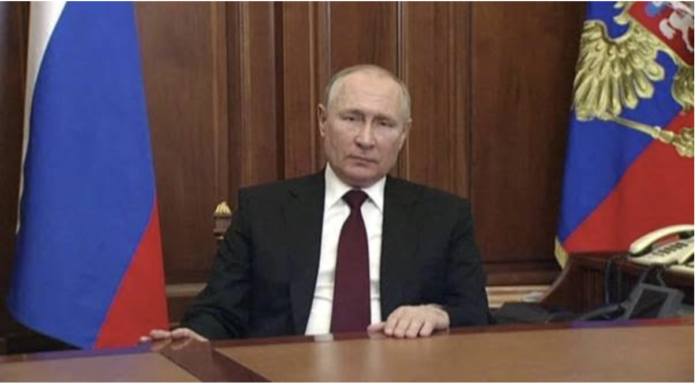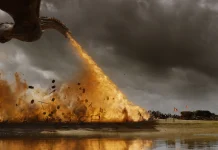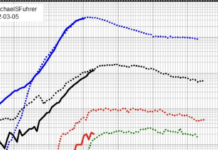In the last twenty-four hours the situation in Ukraine has continued to develop according to predictions. The peace talks in Belarus finished with a commitment to negotiate again, at the same time as a 64-kilometre-long column of military hardware advanced on Kiev.
The satellite images of military equipment moving towards Kiev are useful because they confirm that the Russians are massing forces in that area. More importantly, we can deduce that Russia has control of the airspace north of Kiev because movement of this nature would not be happening in daylight if there was a significant threat of air attack.
This observation does not run contrary to the Pentagon’s reports of the Ukrainian air force still being able to contest the air battle. Instead, it means that the Russians are concentrating their air resources in the area north of Kiev, confirming that the campaign’s main effort is still Kiev. This represents the massing of force prior to the assault that has been predicted, the satellite photos predominately show trucks and other logistic vehicles bringing forward ammunition and other supplies for the attack.
This build-up of forces will not happen overnight and continued sporadic shelling of Kiev is taking place as the Russians surround and probe the city. A deliberate attack has not started at this stage and the key indicator of it will be the use of huge amounts of artillery.
Yesterday, the Pentagon reported that roughly a quarter of Russian forces remained uncommitted. From a military perspective this is vital information. Any military operation requires reserves or forces that are not committed to battle that can be rapidly deployed to exploit a break through or to encircle an enemy. This campaign started with two thirds of the Russian force uncommitted and in less than a week Russia’s reserves have been reduced significantly without achieving a break though or a significant advance. Essentially, the Russians have had to use their reserves up too soon, committing them to battle too early and now lack a significant reserve echelon to exploit success. This has some serious implications for campaign planning.
The first implication is that the lack of reserves means that a deliberate attack on Kiev is likely to be an all or nothing operation. In simple terms Russia gets ‘one shot’ to subdue the city and we can deduce that psychological warfare is a key part of that battle. The long columns of trucks moving in daylight to Kiev send a message that Russia dominates the airspace and that there is a large force descending on the city. Next, we will see more calls to surrender that serve to legitimise the attack and offer a chance for an easy Russian victory.
Further, when the attack is mounted it must be well prepared and overwhelming. The Russians do not have the capacity for a second deliberate attack. Current operations around Kiev represent Russian probing attacks and aggressive patrolling to find out about the Ukrainian defences. The Russians are reconnoitring the city.
The real attack will involve a number of phases probably starting with cruise missile and rocket attacks to knock out any remaining air defence systems, followed by aircraft bombing known Ukrainian positions. Then there will be a slow advance in large numbers supported by lots of artillery. The initial attack could be preceded by use of thermobaric weapons at key points to ‘break in’ to the defender’s lines. Essentially, we will see it develop slowly over a period of days culminating in infantry entering the city in large numbers.
The lack of reserves second implication is that it forces the Russians to commit to one axis of advance. In this case Kiev, so we are unlikely to see significant developments in other parts of Ukraine. Recent reports of shelling in Kharkov do not at this time indicate developments of an offensive in this area.
Yesterday, further information came out on the web about the Ukrainian use of Turkish supplied drones to spot Russian armoured vehicles and guide anti-armour missiles. This tactic is not new first being used in the 2020 Nagorno-Karabakh War between Azerbaijan and Armenia. However, the fact that these systems are operating effectively adds weight to the hypothesis that the Russian’s are not as tactically effective as they were predicted to be when faced with advanced Western anti-armour missiles and new technology like drones.
We are also seeing more reports of flagging morale in Russian soldiers and general disorganisation. Tik Tok is full of videos of wandering Russian vehicles, lost or run out of gas and while this is anecdotal evidence it contributes to the picture of an army over-extended. An army that is losing control of its poorly trained and unmotivated soldiers operating in a dispersed manner and at the extent of their logistics train. While the Russian’s force of 120 battalion battle groups looked fierce on paper, we are witnessing the difficulties of operating using this doctrine. It was always going to be a hard job bringing together battalion battlegroups from all over Russia and moulding them into a fighting force.
After listening to the network centric warfare debate for about twenty years and watching these tactics develop around the world, I understand the difficulties of actually fighting this way and I would love to know if this tactical model was decided upon because of a fast-talking futurist selling the idea to Putin or if the Russians really did think that the Ukrainians would collapse. Remember Donald Rumsfield and Dick Cheney selling a ‘cheap’ occupation of Iraq by disbanding the Iraqi Army and employing private military contractors to the United States twenty years ago? Net-work centric tactics work but requires lots of logistics, lots of training and motivated professional soldiers all things the Russians appear to lack.
The Belarus offer of troops also contributes to the emerging picture of an exhausted army that has made some serious operational planning errors, like trying to use high tech, dispersed tactics without the logistics and training required to do so. I am sure that this is a last option for Putin, it means admitting that the vaunted Russian army has failed. However, it provides another option before having to escalate without using nuclear weapons.
The situation is tough for the Russians, over extended and without a large reserve they lack tactical flexibility. In a previous article I said that if I was a Russian commander, my advice would be to hold at Kiev, dig in there but present a threat that fixes Ukrainian forces in that area. Concentrate in the open country, ‘tank country’ in the north-east near Kharkov. Then use large amounts of armour supported by artillery to suppress anti-armour weapons to break through the Ukrainian defenders and regain the initiative.
Based on the Pentagon’s assessment of Russian forces committed I don’t think trying to regain the initiative in the north-east would be a workable plan at this point. The Russian reserves are too small, even if an attack in the north-east achieved a break through near Kharkov there would not be enough follow-on forces to exploit the situation by driving approximately 350 kilometres west to Kiev. Or even the possibly better option of driving south-west approximately 200 kilometres to Dnipro and linking up with Russian forces already in the south-east.
Kiev is now the Russians only chance of success. In my opinion they will fail. The Ukrainians are fighting hard and have good leadership. Advanced anti-armour and anti-aircraft missiles are flooding into Ukraine from Poland. Fighting in urban areas is incredibly costly and difficult and the Russian’s simply do not have enough resource to capture the city.
So at the end of D + 6 let’s look at our predictions:
- Kiev remains the decisive point in the campaign. In fact as Russian reserves deplete a push on Kiev becomes a necessity rather than an option.
- Kiev will not be taken, currently it appears that Russia lacks the combat power to take a city this size that is well-defended. However, expect the battle to be long and probably culminate in a stalemate rather than a clear victory.
- Putin’s nuclear rhetoric is still concerning and there is a risk that there may be a nuclear show of force. A demonstration designed to ‘scare off’ NATO and international support, ‘escalating to de-escalate’.
- Russian activity across the remainder of Ukraine will continue to slow down as Russian Forces consolidate, reconstitute and dig-in.
In summary, we are watching the ground war grind to halt. The gambler has one last conventional card to play, capturing Kiev. At this time the Russians being able to do this seems unlikely. A more likely scenario is a large attack, followed by weeks or months of street fighting culminating in paralysis as the Russians run out of reserves but the Ukrainians lack the forces to completely evict them from the city.
The problem is that there will be people in the Russian military making the same analysis and starting to look for options. Russian options are limited; they can mobilise more soldiers an activity that takes time and money, which is fast running out because of the West’s economic sanctions. Or, they can accept Belarus military aid which as well as being politically embarrassing is unlikely to significantly influence the battle. Or, they can use nuclear weapons, which will certainly create a dilemma for NATO. Would that action break the current unity of the alliance? Would NATO nations be willing to risk nuclear war to save Ukraine? Let’s hope that we don’t have to find out. That in the Russian command structure there are reasonable, sensible people thinking ahead and looking for other options.
Ben Morgan is a tired Gen X interested in international politics. He is TDB’s Military analyst.






The fact that the Russian column is so long means that it is potentially useless to create multiple attack points or fronts until it can be dispersed into front line positions. That column is linear but needs to be arranged circularly around Kiev to have any attack potential. A tank 60 kilometers from Kiev may as well be in Red Square.
The column will be most vulnerable when it splits into sections at dispersal points. Air cover gets stretched. No doubt the Ukrainians will have identified those dispersal points and strengthened their defenses accordingly.
Reminds me of Operation Market Garden. Airborne troops capture the ground but the armoured columns to support them is effectively contained on the roads leading to the drop zone. Once the armoured column is stopped, mopping up the ground forces is than easy.
Russian generals face the same problem. Troops start to take Kiev but they need to be able to defend their supply line. Ukrainian forces will do just as the Germans did in Operation Market Garden. Stop or stifle the supply line so that the Russian boots on the ground in Kiev will be hamstrung through lack of reinforcements, ammunition, food, etc. Troops could possibly maintain an effective battle presence for about a week if not regularly supplied. Fatigue becomes a major problem.
https://www.nam.ac.uk/explore/market-garden
“Although units of 30 Corps captured Nijmegen bridge in conjunction with the US 82nd Airborne Division, they could not reach the furthest bridge at Arnhem. Much of its advance was along a single narrow causeway, which was vulnerable to traffic jams and German counter-attacks.
In some places the advance was hindered by marshes that prevented off-road movement. Throughout the battle the Germans also showed a remarkable ability to put together scratch battle groups that fought to delay the armoured columns.”
Now if the Ukrainians were to attack the column in a pincer movement like the Russians did to the German supply line at Stalingrad, today’s Russian generals may rue the day there was no consolidation of occupation on a wider front than just the roads to Kiev.
Western media sum it up perfectly:” These aren’t poor brown people in some random subhuman country being victimized, these are civilized blond-haired blue-eyed gods and heroes, in EUROPE”.
Noice analysis.
Ukraine Government is nasty…jailing opposition parties/leaders, locking down media outlets …all before the war
Yep and Putin is the ultimate peacemaker?
A good analysis, thanks.
Looking further out:
> Kiev could be Putin’s Stalingrad because a bombed out city is very hard to penetrate. Every open window has a potential sniper in it and the streets will be barricaded or strewn with rubble making the movement of armour difficult. It will require a brutal slogging match to take the city with every inch gained marked in Russian blood.
> If he somehow takes Kiev, he’s then got to try and hold it. Expect its defenders to maintain a steady pressure on the invaders such that there is a steady stream of body bags returning to Russian Mothers. One of the key drivers for the invasion was the gradual demographic suicide of Russia, but it seems Putin is prepared to gamble with what little youth there is left in his country. Just as you say, the Ukranians will also be out in the countryside attacking on soft flanks and supply lines.
>His army is largely conscripted, so this invasion will just encourage the youth get the hell out of there at ever increasing numbers; exacerbating the demographic problem. Abuses by permanent force of conscripts during basic training are well documented. Who in their right minds would subject themselves to that?
> The West has woken up and is busy rearming and resupplying the Ukrainians. Expect the Russians to face a lot of Stingers and Javelins.
So it comes to the Big Question: Facing failure, will Putin raise the stakes?
This situation seems to be about- when your opponent is making a mistake it is best not to interrupt them.
Given that the end game for the Ukraine military planners will be ‘ street by street ‘ fighting and that time is now on their side with Western/Nato resupply i would think they would be OK with the cities being bombed, so long as everyone is dug in -thinking London in WW2 – and focusing on easy Russian targets for their new Stingers – then reemerge as Russians move into the city -thinking Vietcong and Stalingrad.
This approach wont long pretty but will have a good chance of success against a part-time Russian army -thinking Afghanistan. History repeating itself!
Thats pretty much the opposite to what Im hearing from both Russian and American sources. If you read this article you could conclude that the Russians are / have surrounded Kiev, Kharkov, the Ukrainian army in the Donbass. That they have air superiority and have not to date utilised artillery or rocketry to assault civilian areas. None of that is disputed by this article.
You might also ask why no Russian assault on urban populations?
There’s a typical Western military viewpoint that thats what the Russians are there to do. Why would they bother, the Ukrainian army may be fighting well, but they stand no chance of repelling the Russians. Thats just wishful thinking. As is low Russian morale. Armies that advance aren’t suffering low morale.
My suspicion is that the Russians are meeting their objectives and timeframes.
I agree Nick
All the MSM is claiming Russia is failing in her objectives. , while ignoring what Russia’s stated objectives are, and supplanting them with other assumed objectives that russia has mostly stated are not it’s objectives.
D J S
of course putins plans maybe to surround a militarily (though politically important) unimportant city and starve it out…time is running out though if the russians could have got it done quickly the west would huff and puff but ‘fait accomplis’, the longer it drags on the worse for putin, I’m sure his generals are telling him armour and cities don’t mix so siege is his only option…and that’s messy
You are missing something G. The cities are full of Russians. From a Russian angle sending troops to kill Russians might be unnacceptable to those troops. And why would those Russians in the city resist?
I suspect the Russians will besiege, cut off supplies, and leave open escape corridors. Europe then gets a refugee crisis. What they are aiming at is regime change and then to get out.
Time is on the Russians side, NATO cant act militarily. Sanctions will hurt the West more. German industry stops without Russian gas and oil. US grade deisel needs Russian heavy crude mix or their trucks stop running. Oil hit $150 a barrel today.
My take is that the West are looking for a way to save face whilst appearing to resist the Bear. Meanwhile they may covertly tell the Ukraine to strike a deal.
Of course, I could be just cynical and wrong.
“My take is that the West are looking for a way to save face whilst appearing to resist the Bear. Meanwhile they may covertly tell the Ukraine to strike a deal”
What strikes me as bloody irresponsible if your take is not right’ is America and Europe pumping more and more arms into Ukraine and offering all encouragement to defend themselves against what they clearly acknowledge is a hopeless mismatch (in spite of what this writer is trying to argue.) . They are just setting the Ukraine up for a disaster , just a longer bloodier war and the same end result. The only logic to it could be if they intend that Russia will be sufficiently compromised by Ukraine’s efforts that they might be better positioned to take Russia on after Ukraine is “used up”.
If the genuinely want to help Ukraine and be a friend they have to either do as you suggest and encourage them to make a deal, or get in and help them. that would of course immediately lead to WW3 and nukes so they won’t. But that leaves them no justification to do anything but what you suggest.
D J S
Well put. It is irresponsible.
for excellent analysis from Russian point of view:
https://thesaker.is/